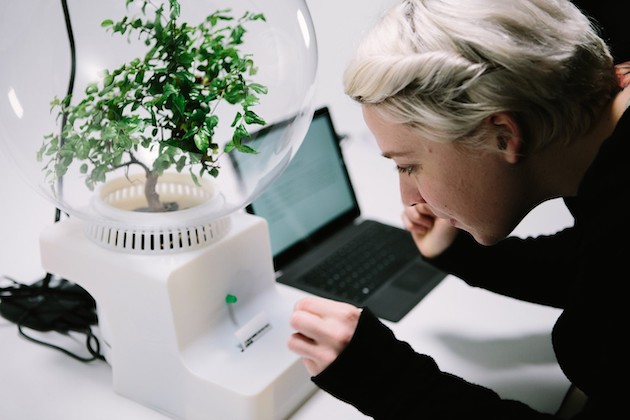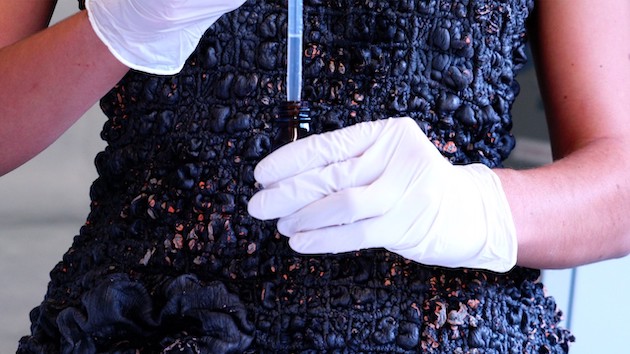 Helene Steiner with her Project Florence concept. Courtesy Helene Steiner
Helene Steiner with her Project Florence concept. Courtesy Helene Steiner
Each living cell contains a tiny machine that takes in raw materials and, thanks to a recipe inscribed in the DNA, assembles proteins – the stuff that life is made from. But what if we could control that DNA, to make new living materials, medicines and DNA-driven processing power?
Helene Steiner, a London-based designer and engineer, co-founded Cell-Free Technology (CFT), a company that makes biocomputers, in October 2017. CFT describes itself as ‘cell-free’ because, as Steiner explains they have managed to extract the cell’s core robotics, so that new DNA can be implanted in a controlled environment.
After speaking at an event hosted by UCL Bartlett’s Bio-ID lab at their hybrid science-architecture lab, Steiner explains how such technology can lead the next generation of design.
ICON: So, how does it work?
Helene Steiner: If you look at the cell, it’s a little bit like a factory. And inside the factory, you have a machine that is called the Translation-Transcription Machinery. That reads DNA, almost like the code of life, and then translates it into proteins. And why that is so important, is because proteins are pretty much everything that controls the cells inside, but also outside. [From how] our hair grows, to how our body defends against any kind of virus, is actually proteins, defined by the DNA code. Normally, you use this in laboratories, where you look into finding, for example, a medicine that can help me defending a virus.
Tube holders for Bixels project by Cell-Free Tech. Courtesy Cell-Free Tech
But the challenge there, though, is always how do I find the right code? How do I write the code of life? At the moment the process is very, very long: you look at nature, extract the gene, and then you try to express it in a cell. It’s a very long process where you need a full bio-laboratory and highly skilled people who’ve studied microbiology or synthetic biology. And it can take weeks, even years, to actually find the right protein that is doing what you’re looking for.
ICON: And this is where ‘cell-free technology’ comes in?
HS: What Cell-Free does is, we actually remove the Translation-Transcription Machinery from inside the cell. We pop those cells open and then only work with the machinery, which allows to that we can just directly add a gene of interest, the DNA, and see if that would produce a protein. You can submit your DNA sequence and we let you know in half an hour if that would make a protein or not.
ICON: From the perspective of a designer or an architect, what’s really exciting is the kind of outputs that you’re looking at – proteins – which are very much more material than standard digital computing. Do you have a vision of the longer term for what the output looks like?
HS: Because we are removing the machinery from inside the cell, the cell can’t reproduce itself anymore and normally you would only be allowed to use the techniques inside the laboratory. But with the cells extracted, what is really exciting, we actually can use it outside of labs. It can’t reproduce itself – meaning it’s safe. So what allows you now to do is actually, you could imbed the technology in materials. You could create bio-sensors that you imbed in paper or in textiles or in durables that can [detect] pollutants in the air. Bioscent by Piero D’Angelo, a resident designer at Open Cell. Photos by Lavinia Mustaph
Bioscent by Piero D’Angelo, a resident designer at Open Cell. Photos by Lavinia Mustaph
That is one thing which personally excites me a lot, that kind of product design. The other one, what I think is really exciting is if you look into the nano-scale, you can also look into creating new proteins and materials from scratch, almost. You can look into more sustainable materials. I don’t know if you’re aware of this, but we built a place in West London that is called Open Cell. So if you have almost 70 shipping containers for work about bio-technology, and what we see a lot happening is there are more and more new materials coming in. The wish to create a more circular economy and I think if we start really designing from a micro-scale I think there are a lot of opportunities to create more sustainable systems when it comes to the products and the architecture, actually building.
ICON: Are there examples of people you’ve collaborated with, people who have tested their products through your processes that you can talk about that are building products or building towards different solutions?
HS: We have people looking into the fashion sides, there’s a lot of opportunities for durables. So if it kind of comes to you, bio-sensors that either detect any particular conditions or you can kind of detect pollutants in the air, et cetera so there is people working on that. There’s a lot of interest when it comes to really completely making new materials. There’s one colleague, at Imperial College for example, who just built the first fibre that is truly built digital, molecule by molecule, but then actually produced in a laboratory, in a cell extract, that is [to say], cell-free.
ICON: Do you have a vision of how this fits into the world at large? Is it a replacement for standard computing or do we expect to see it take very different forms?
HS: There’s so many directions that I think will influence. I think when it comes to the medical applications, it allows you to create much more personalized therapies. When it comes to new materials, there are a lot of projects that look into replacing [colour] pigments [for industry] because that is a big challenge when it comes to sustainability.
I think there are more questions than answers to be honest. When it comes to computation, some people are looking into using the DNA to store data – almost making hard drives out of biology. The other direction is a combination of computation and biology [known as bio-computing] that gets very powerful. Figuring out such big challenges, you need machine learning really to be able to cope with the complexity of biology and to be able to interact with it and program with it.


















